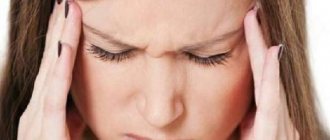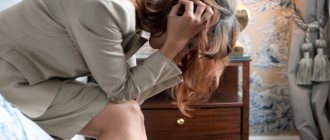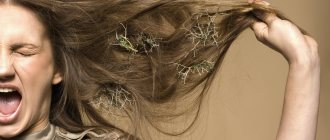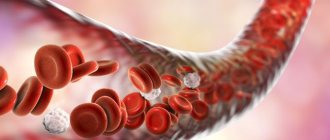07.03.2013
Maltseva Marina Arnoldovna
Head of the consultation department - neurologist, specialist in the field of extrapyramidal pathologies, doctor of the highest category
The problem when a person feels tinnitus is quite common and unpleasant in nature, as it often interferes with the daily activities and concentration of the person suffering from such an illness. Tinnitus can have a wide variety of causes, which will characterize the symptoms in each specific case, and treatment will also depend on the cause. It’s worth mentioning right away that tinnitus rarely becomes an independent disease and is much more often just a specific symptom of another disease. Let's look at the most common factors and causes, classification, as well as treatment for such an interesting symptom or even disease.
Medical certificate
Tinnitus can be an independent nosological entity, i.e. disease, but much more often we are part of a syndrome complex of some other disease. In the field of otorhinolaryngologists, tinnitus is usually called the term tinnitus. Problems with the ears, or more precisely with the sensation of tinnitus, are not uncommon in the practice of otorhinolaryngologists. According to statistics, more than 8% of the population of developed countries experiences this unpleasant symptom, and even more people live with it without seeking qualified medical help.
Tinnitus is a complex symptom and difficult to assess objectively, since it often does not have any external stimulus. Almost all people suffering from tinnitus notice a noise in the form of a high-pitched ringing. The high-pitched sound may resemble the characteristic ringing of a bell. The causes of this symptom or disease can be very diverse, from the banal formation of cerumen plug in the cavity of the external auditory canal, to complex nervous electrochemical disorders in the central nervous system of the brain.
In adults
Adult patients are characterized by left- or right-sided eustachitis affecting one side without fever, but with a complex of unpleasant symptoms. Patients suffer from:
- congestion in the ears, decreased hearing (low frequencies are almost not perceived);
- autophony (loud distorted perception of one’s own voice in the form of an echo);
- sensation of fluid in the ear;
- headaches or earaches.
Improvement occurs briefly when chewing or after swallowing saliva, food, or when tilting the head due to a short-term opening of the Eustachian tube and a change in fluid level.
Causes of tinnitus
Causes of tinnitus. This symptom can have a huge variety of causes and factors contributing to its development. All reasons and factors can be divided into several main groups:
- Age-related degenerative changes associated with the tissues of the hearing aid. This phenomenon is called presbycusis and develops in old age in people over 65 years of age.
- Physical damage to the cochlear organ of the inner ear. Occupations that require constant exposure to high-volume areas, such as tractor drivers or road workers, contribute to physical damage. Constantly listening to music through headphones at high volume can also cause physical damage to the inner ear.
- Iatrogenic factor or the use of drugs whose side effect is ototoxicity, i.e. disruption of the physiological functioning of the hearing organ. Damage to the inner ear can occur as a result of the use of certain antibiotics, such as gentamicin, as well as when taking large doses of acetylsalicylic acid.
- Defects in the anatomical structure of the auditory ossicles located in the cavity of the middle ear, as well as any other pathological condition affecting the middle ear.
- Head injuries with damage to the structures of the inner and middle ear.
A special place is occupied by diseases not related to the functioning of the hearing aid, but also having the ability to cause noise in the ears and head. Such diseases can be either systemic in nature or localized in close anatomical proximity to the hearing organ. Diseases not directly related to the hearing organ cause the so-called pulsating form of tinnitus. Noise in the ears and head causes not related to the hearing organ:
- Atherosclerotic disease. The manifestations of atherosclerosis depend on many factors, however, the most important is the deposition of cholesterol under the endothelium of the vascular wall. Excessive cholesterol deposition leads to the formation of atherosclerotic plaques in the vascular wall, which inevitably leads to a decrease in the circumference of the vessel and disruption of the rheological properties of the liquid part of the blood. Loss of elasticity of the vascular wall leads to a change in laminar blood flow to turbulent, which, when localized close to the inner ear, leads to the appearance of constant high-pitched noise.
- Arterial hypertension is one of the most common diseases throughout the world. With high blood pressure numbers, a murmur in the left ear or a murmur in the right ear may occur, which is a characteristic symptom of hypertension. Taking drugs or foods that activate the nervous system, such as caffeine, can aggravate the symptom.
- Pathology of the vascular wall and microvasculature. The presence of arteriovenous shunts leads to a rapid discharge of arterial blood into the venous bed, which is accompanied by the occurrence of vascular tinnitus.
- Oncological diseases localized to the head or neck. The most common oncological process leading to the formation of the symptom of noise is acoustic neuroma. The tumor is benign, but causes painful tinnitus that cannot be relieved by anything.
Folk remedies
If a man has a whistling sound in his left or right ear, then you can help get rid of it using folk remedies. For this, the following decoctions are prepared:
- Melissa tincture. To do this, take finely ground lemon balm (1 tablespoon), pour a glass of boiling water over it, leave for half an hour and filter. You need to take the infusion for two weeks, twice a day.
- Dill decoction. Half the volume of boiling water is poured into a thermos, dill is poured in and infused for an hour. You need to take a spoon before meals, three times a day.
- Propolis tincture. Propolis must be mixed with olive oil. To do this, take a proportion of 1:4. The mass is thoroughly mixed and applied to cotton swabs. They are then inserted into the ears for an hour and a half.
Traditional medicine can relieve discomfort, but it is not always possible to treat the disease that caused it.
Therapy with folk remedies can only be used in parallel with conservative treatment methods. Only in this way will the patient get rid of whistling in the ears forever.
Certain states
Tinnitus, what to do? If you are tormented by constant tinnitus, then you should not hesitate to contact a specialist - an otolaryngologist for advice and medical help. In some cases, tinnitus can be a manifestation of serious illnesses and even brain damage. Let's look at the most common forms of tinnitus and what they are associated with.
- Constant tinnitus - this form is characteristic of atherosclerotic damage to the cerebral vessels, as well as the arteries of the neck. This kind of tinnitus does not go away on its own and is characterized by a long course that is not amenable to drug therapy. The patient quickly gets used to the constant noise, and it slightly reduces the person’s ability to work.
- Noise and pain in the ear - this symptom is a manifestation of inflammatory processes localized in the area of the inner and middle ear. Inflammatory diseases of the inner ear are quite rare, but otitis media is common. Otitis media occurring with the formation of pus can lead to a change in the anatomical shape of the auditory ossicles, which can ultimately manifest itself in the form of a sensation of various noises. The noise is also constant, but its intensity and shape change periodically.
- Pulsatile tinnitus – this noise is a characteristic symptom of hypertension. With high blood pressure numbers, the pulse wave increases, which leads to the appearance of rhythmic pulsating noise in the ears. When the pressure returns to normal, this noise disappears on its own. Another, but rare, cause may be erythrocytosis, a condition in which there is an excessive amount of red blood cells in the blood, which in turn leads to a violation of the rheological properties of circulating blood.
- Tinnitus and dizziness are the downside of hypertension. With low pressure, a similar noise in the ears is often observed, but it is always accompanied by dizziness, since there is not enough oxygen in the brain tissue. Another cause of noise with dizziness can be severe atherosclerosis with the blocking of most of the lumen of the vascular wall by an atherosclerotic plaque.
- One way noise. Noise localized in the right or left ear occurs when the vascular wall is damaged on only one side. This can happen if the patient has systemic autoimmune diseases or atherosclerotic disease.
Prevention
Treating whistling in the ears with folk remedies is very reassuring in that you will not go deaf or end up in the hospital. But it’s better to prevent such a problem from developing than to then think about how to get rid of it.
Preventive measures are quite simple. You just need to avoid those factors that directly affect the appearance of whistling in the ears.
Doctors recommend minimizing the consumption of salty foods, not listening to music too loudly for a long period of time, the body should be in complete silence for at least 30 minutes a day, and not allowing blood pressure to increase.
If the whistling is already present, then you need to adhere to some rules so that the situation does not escalate:
- Don't expose yourself to loud noises or listen to music very often. Ears should be in comfortable conditions.
- Blood pressure should always be under vigilant observation in order to pay attention to the signs of hypertension in time and get rid of them.
- Ears should always be warm, so wear hats when it's cold outside.
All diseases that somehow affect the ear are treated by an otolaryngologist. He is obliged to carry out all the necessary examinations to accurately determine the cause of the whistling.
Investigations consist of x-rays, motor coordination tests, and blood tests.
What to do if you have whistling in your ears
I advise doctors to completely give up any bad habits, adjust blood circulation in the body, and strengthen the immune system.
If you are already concerned about this problem, then you should purchase special devices that are designed to reduce the noise level.
They also have a beneficial effect on all body systems. You can also use ear drops that can soften wax plugs. But you can drip them into the ear only after a preliminary examination and consultation with specialists.
♦ Category: Folk recipes.
Classification of tinnitus
To determine the cause of tinnitus and subsequently prescribe effective treatment, it is necessary to have an understanding of the nature of the noise and its intensity. The matter is complicated by the fact that this symptom in most cases is subjective, which imposes certain difficulties on diagnosing the disease that causes tinnitus.
Russian Soviet academician of the Russian Academy of Sciences I.B. Soldatov developed a classification based on the degree of noise, valuable for clinical medicine, which distinguishes four degrees:
- 1st degree – noise does not reduce performance, you can get used to it;
- 2nd degree – tinnitus is severe, especially at night;
- Grade 3 – the noise is constantly disturbing, the patient has to be distracted by it. Sleep is disturbed and irritability appears.
- Grade 4 – the noise is very difficult to tolerate and constantly disturbs the patient. Performance is almost completely absent.
In practice, this subjective assessment makes it possible to set the degree of tinnitus from mild to critical, which affects the specialist’s management of the patient.
Otorhinolaryngologists distinguish several types of tinnitus:
- Objective noise, which is also audible to others and directly to the specialist;
- Subjective is the most difficult. The noise is only audible to the patient;
- Vibration – occurs when any anatomical structure vibrates, such noise can be heard by a specialist.
- Non-vibrational - sounds that are a pathology of the auditory nuclei of the medulla oblongata.
Based on the localization of noise, several types can be distinguished and all of them are non-vibrational in nature:
- Central – generated in the center of the skull;
- Shifted to the periphery - the noise is heard only in one ear;
- Single-sided or double-sided.
Why is there tinnitus? There is also a classification according to the etiological factor, which correlates with the above reasons.
Acoustic trauma
Being in places with a lot of intense noise and high volume can lead to physiological adaptive hearing loss. Reduced sensitivity of the cochlear organ compensates for the intense sound wave and provides protection for the inner ear. Acoustic trauma in most cases resolves without the use of drug therapy.
Air pressure damage
It can occur due to sudden changes in pressure in gaseous and liquid media. For example, quite often barotrauma occurs in airplane pilots during a sharp climb or during parachute jumps. Barotrauma is often accompanied by dizziness, nausea and vomiting, general weakness and a feeling of stuffiness in the ears.
Otosclerosis
A chronic non-infectious disease of the hearing organ, occurring with the addition of degenerative changes in the cellular component of the inner ear and cochlear organ. Otosclerosis is a multifactorial disease and occurs more often in adults.
Arterial hypertension
The noise in this condition is accompanied by a headache and is pulsating in nature. Measuring blood pressure allows an accurate diagnosis. This symptom is typical for people in the older age group, as well as those who are overweight or obese.
Use of ototoxic drugs
The iatrogenic factor is quite rare, but if drugs are used carelessly or incorrectly, it can cause tinnitus. The use of antibiotics with ototoxic effects leads to inhibition of the functional activity of the auditory nuclei of the medulla oblongata and the occurrence of sensorineural hearing loss or complete loss of auditory function. Very often, the very first manifestation of the ototoxic effect of the drug is hearing loss with the addition of tinnitus.
Osteochondrosis
Tinnitus can also occur when blood flow through the vertebral arteries is impaired as a result of osteochondrosis. A decrease in blood flow to the pyramid of the temporal bone leads to a deterioration in the functioning of the neurosensory structures of the inner ear and the auditory pair of nuclei of the medulla oblongata.
Exostosis
Overgrowth of bone tissue that forms the inside of the external auditory canal. This pathological process leads to a change in the physical properties of the sound wave, its distortion, which can ultimately lead to the formation of noise.
Neuroma
A benign tumor from the nervous tissue of the auditory nuclei and tracts is asymptomatic for a long time, but as it increases in size it leads to compression of the nerve fibers running from the inner ear to the auditory nuclei and leads to noise and hearing loss. Also, due to the close proximity of the tumor process to the tissues of the cerebellum, symptoms such as dizziness may occur.
Sulfur plug
Earwax impedes the normal passage of sound waves through the external auditory canal, which leads to the formation of noise and a feeling of fullness in the ear. Tinnitus resulting from the presence of wax plugs can be easily eliminated by cleansing the external auditory canal or by rinsing it.
What complications can a ringing in the head cause?
As a result of this problem, a person begins to take analgesics, antidepressants, NSAIDs, muscle relaxants and nootropics. But I can’t get rid of the ringing in my head.
Along with this, dangerous consequences may develop, such as:
- Memory loss, partial or complete.
- Oxygen starvation of the brain, which leads to a decrease in intelligence.
- Wear and tear of blood vessels, which leads to stroke or heart attack.
- And the most dangerous consequences of untreated noise in the head can be disability and even sudden death.
Diagnostics
In order to understand why there is noise in the ears, you need to know exactly the reason that caused it. To establish a clinical diagnosis and effective treatment, it is necessary to conduct special instrumental and laboratory diagnostic studies. Only a comprehensive examination allows us to identify the exact cause of the disease.
In the practice of otorhinolaryngologists, many special studies are used to diagnose tinnitus. First of all, the specialist will conduct a detailed questioning and determine the degree of noise intensity. After collecting a history of the disease, the patient will be prescribed a series of tests to confirm the disease.
Otoscopy
It is carried out directly at an appointment with an otolaryngologist and consists of examining the external auditory canal. Otoscopy immediately allows you to confirm or exclude the presence of the following diseases, the characteristic symptom of which is tinnitus:
- Blocking of the lumen of the ear canal with wax plug or other foreign object;
- An inflammatory process occurring in the outer or middle ear, including a boil;
- Exostosis is the growth of the bony part of the external auditory canal, which leads to a narrowing of the lumen.
The study is carried out using a device - an otoscope. The otoscope allows you to obtain good visualization of the anatomical formations of the outer ear and eardrum.
Audiometry
Pure-tone audiometry is used to determine the sensitivity threshold of the hearing organ. This study allows you to determine the amplitude of the noise and identify the hearing threshold. When examining for tinnitus, both an increase in the hearing threshold and a decrease in it can be detected.
Auscultation of the temple area
For auscultation, the specialist uses a special device - a phonendoscope, which allows you to pick up vibration or any other noise. A pulsatile murmur occurs when there is a vascular component, such as an arteriovenous shunt or hypertension. A specialist can also identify a clicking noise that occurs due to muscle contractions of the soft palate.
Additionally, the study may include angiography of the cerebral arteries, computed tomography and magnetic resonance imaging of the head and neck. These studies allow us to obtain a clearer understanding of the pathological condition and allow us to formulate the correct treatment tactics.
How to treat tinnitus is a difficult question. With subjective noise, diagnosis is seriously difficult, since there is no way to objectively assess the degree and intensity of noise. An experienced otolaryngologist will tell you how to get rid of tinnitus.
Noise in the ears and head has many causes, and each specific cause determines its own treatment tactics. Noise in the ears and head treatment. Treatment consists of prescribing special angioprotective drugs, for example Octovegin. When tinnitus occurs as a result of degenerative changes in the tissues of various parts of the ear, it becomes necessary to prescribe nootropic drugs to improve the trophism and metabolic activity of the nervous tissue.
Effective treatment of any form of noise requires the comprehensive use of not only drug therapy, but also various physical procedures. The use of oxygen therapy using hyperbaric oxygenation has shown high effectiveness in eliminating noise. In addition to medications for the treatment of tinnitus and head noise, a mandatory component of treatment is the use of a course of vitamin therapy - B vitamins are especially valuable for patients, as they improve the functioning of the body’s nervous tissue.
In difficult cases, when noise is associated with sensorineural pathology, radical treatment is the installation of a cochlear implant, which allows you to get rid of not only noise, but also sensorineural hearing loss.
Treatment of tinnitus caused by a vascular component will also depend on the specific pathology. In case of hypertension, antihypertensive therapy should be started immediately on an ongoing basis. Normalizing and maintaining blood pressure numbers within normal limits will allow you to forget about such an unpleasant symptom. If the noise is caused by atherosclerotic changes, then statins or fibrates are necessarily added to therapy - drugs that help reduce the progression of atherosclerotic changes in the vascular bed, as well as drugs that activate metabolic processes in the body’s tissues.
When noise is caused by a muscle component, drugs with a muscle relaxant effect, for example from the benzodiazepine group, must be added to drug therapy. The drugs are used only after consultation with the attending physician.
Please note that self-medication almost always does not give a good and stable result, but only delays the visit to a specialist. If you do not seek consultation and treatment in a timely manner, there is a risk of missing the initial period of the disease, which can lead to progression of the disease and the development of complications. Pay attention to yourself and your symptoms, stay healthy!
Clinical Brain Institute Rating: 3/5 — 54 votes
Share article on social networks
Treatment
Treatment is prescribed by an otolaryngologist and a neurologist. In some cases, the help of a cardiologist and endocrinologist is required. Prescriptions depend entirely on what disease was identified during diagnosis.
What treatment may include:
- Drugs for the treatment of the underlying disease - antibiotics, antipsychotics, hormonal drugs;
- B vitamins;
- Physiotherapy and mechanotherapy;
- Psychotherapy in combination with meditation and breathing exercises;
- Noise maskers - for example, recording the noise of a forest or sea;
- If necessary, surgical intervention - removal of the tumor, impact on the sympathetic nerve nodes, surgery to improve hearing.
In the medical department you can get advice from doctors: a neurologist, an otolaryngologist, a psychotherapist and a surgeon. Make an appointment right now so as not to waste time and get qualified medical care.
With us you can get tested and undergo the necessary procedures during the treatment of tinnitus and related diseases.
“Which ear is it buzzing in?”
People usually associate this symptom with high blood pressure and vascular problems. However, this is far from the most common cause of tinnitus.
In general, in all patients this symptom manifests itself differently: the noise can be loud or quiet, on one side or both at once, constantly or from time to time. The noise can be of the same frequency or of different frequencies (for example, intermittent or pulsating). It is important for the otoneurologist to know all the characteristics of the ear noise of a particular patient, as well as its triggers (the causes of occurrence and factors that change the nature of the noise) in order to direct the diagnosis in the right direction.
Mandatory tests for tinnitus include audiometry, an auditory tube function test, and a study of the “reflexes” of the middle ear muscles. It is also advisable to conduct noise metry to clarify the frequency and volume of noise. But ultrasound of the neck vessels, so beloved by patients, is unlikely to provide meaningful information. MRI and CT are also performed according to strict indications and are not always required.











